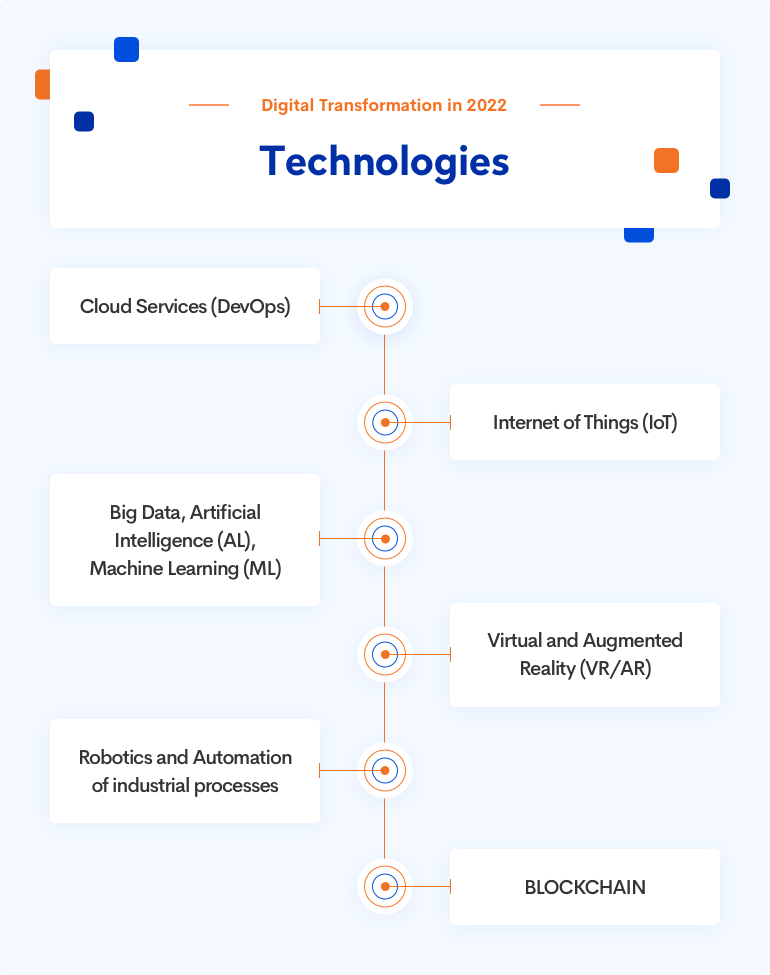Digital transformation is becoming an essential part of today’s businesses. It is not a fad anymore but a necessity for companies that want to stand out from the competition. Why do companies strive for digital revolutions, and when should they start this journey?
The benefits of implementing a digital transformation are undeniable. They help businesses adjust to market needs and changes, as well as save money. Are you ready to explore what digital transformation means today and why it is so important? Read on to find out more and learn what the process looks like. Let’s get started!
What Is Digital Transformation and Why Is It Cropping Up So Often?
There are many definitions of digital transformation, but to simplify everything, we will keep it short. In most cases, it is defined as the well-planned implementation and integration of digital technologies into various business fields to reduce costs and make the work easier and smoother. For example:
- Make time-consuming processes easier
- Change business models
- Improve the customer experience
- Improve the way an organization works
Digital transformation is a broad concept, and by using it, you can improve almost anything. Examples include creating a digital work environment, implementing a new and faster process that makes customer service more efficient, and harnessing a new system to gather information and data. Digital transformation is making people’s lives easier.
Coming up with new solutions is essential to a business, helping to take it to a higher level. It’s worth mentioning that the whole strategy should be crafted to suit the company’s specific needs. Each situation is unique. The final version of the digital transformation depends on the business’s goals and objectives.
Some companies started digitizing their processes much earlier than others by, for example, benefiting from one of the biggest contributors to digital transformation: the cloud. For others, it is a completely new strategy. In this case, a different scope of work is needed to meet their expectations.
Digital transformation is not only for large companies but also for small and medium-sized enterprises. They all can take a significant step into the digital world.
Digital Transformation in Numbers
What can you discover about this topic in surveys? It turns out that there is a lot of interesting information. Check out some of it:
- According to the 2020 global CIO survey, 69% of respondents said that the most important factor that convinced them to choose digital transformation was a need to improve the customer experience. The next most important reason was developing new products and services.
- The BDO survey found that 71% of companies that have implemented digital transformation have seen increases in revenue directly linked to the digital transformation techniques, and 74% have seen increases in profitability.
- According to a survey available on Statista, spending on technologies and services that enable digital transformation is expected to increase to 2.3 trillion USD by 2023.
Is Digital Transformation for You? Three Real-Life Examples
Are you wondering if digital transformation can benefit your business and if it is a good idea to implement it? Nowadays, there is room for innovative solutions in almost every company. Here are some common reasons that drive digital transformation:
- Use of old systems. Are you using tools that are not secure enough? Old systems can be a source of many different problems, and they cause errors. Modernizing them is a great way to increase security, which is currently a very important step.
- Time-consuming processes. Digital transformation can bring many benefits to businesses where the team is engaged in repetitive tasks that can be automated very quickly. Examples include completing data or formulas. Optimizing these tasks can help engage the team in more significant tasks and empower their other skills in order to make changes in the organization.
- Need to improve customer satisfaction. As mentioned earlier, improving customer satisfaction is one of the important reasons that drive digital transformation. If your company includes customer service processes, you can probably point out some that need improvements. It will help you take your customer service to the next level.
Popular technologies in digital transformation
Below we will discuss the most popular technologies used in 2022 in digital transformation.
Cloud computing
When a company scales, it is widespread to use cloud services such as Amazon Web Services (AWS). It primarily enables on-demand delivery of computing services. Instead of investing in their computing infrastructure, which is expensive to build and support, organizations often choose to rent on-demand access to various services such as applications or storage from a provider.
In addition to the easier scaling of the organization, cloud computing affects the more sustainable growth of the organization. A centralized IT infrastructure on external servers allows for more efficient systems and cooling technology and saves electricity.
Internet of Things (IoT)
According to Gartner statistical analysis, it is predicted that by 2022, businesses and significantly the automotive sector will register more than 5.8 billion IoT devices. Why is this such a popular digital technology? IoT makes it possible to connect physical devices to the Internet while collecting the necessary data. The combination of devices and sensors makes it possible to share data in real-time without the need for humans to do so. It is a way to connect the physical world with the digital world.
Advantages of the Internet of Things in digital transformation:
- connects devices and sensors
- improves process automation
- improves efficiency and sustainability
Big Data, Artificial Intelligence (AL), and Machine Learning (ML)
Big Data, or the ability to collect large amounts of data digitally, helps organizations extract helpful information to make business and marketing decisions. For example, it enables data collection about different groups of customers, their website behavior, and buying habits. It, in turn, makes it easier for companies to make changes to meet customer needs. Big Data and data analytics are essential in total digital transformation.
How to use the collected data?
It is where machine learning comes to the rescue. Big data is crucial. The more information a system receives, the more effective it is to process it and apply it later for business purposes. It is a practical solution in smart factories because it improves production efficiency by automating production and facilitating process management.
Virtual and Augmented Reality (VR/AR)
Augmented reality is a transformative technology that enables the perception of a new version of the actual physical world using digital elements, sounds, or other sensory stimuli through technology. The primary purpose of VR and AR is to produce intelligent data that can be implemented in mobile applications.
By introducing these technologies into their business, brands can stand out and excitingly connect with customers, focusing on the customer experience. This messaging, so-called experiential marketing, makes it easier for companies to build strong customer relationships. It has the power to make customers physically connect with companies, maximizing brand engagement and evoking an emotional response. It can simulate, for example, the presence of a product in a physical environment; for example, you can show how specific furniture would look in your apartment. The main goal is to gain intelligent insight into reality before making a purchase decision.
Robotics and industrial process automation
Process automation is essential in the era of Industry 4.0. Tools such as RPA (Robotic Process Automation) support the configuration of software or robots. It allows automating transaction processing, data manipulation, and communication with other digital systems. In addition to automating business processes, RPA reduces the cost of service, reduces the likelihood of error, and can influence collaboration through other advanced technologies such as voice recognition or artificial intelligence.
Blockchain
A blockchain is a distributed database shared by nodes in a computer network. What is its application in digital transformation? It is a technology that plays a role in the cryptocurrency system, guaranteeing the security of data records and building trust without the involvement of a third party.
What else does blockchain technology bring to digital business transformation?
- reduction of transaction costs
- secure, accurate, and transparent data
- data integrity of all participants
Digital Transformation: Our Case Study
Our offer includes digital transformation services, and we can easily share the results of this implementation. We aim to bring innovation to companies’ processes and old-fashioned models. Let’s look at an example from one of our clients, Hevea.
Hevea is a recognized brand that manufactures high-quality mattresses. Its products recently gained popularity, and new challenges began to emerge. The company’s current work methods were not effective anymore. It needed an innovative approach and solutions to take its processes to the next level by automating them. Hevea’s team was mainly using spreadsheets to organize the backlog of orders. As a result, the whole process was delayed, and the team had difficulties organizing everything smoothly. The company was looking for a trustworthy IT partner who could deliver complex solutions to automate production and launch inventory management software. We were delighted to start this partnership.
We developed a functional web application that allows Hevea to track the warehouse. We were responsible for creating a cloud migration strategy and preparing a successful migration. Hevea is one interesting example that shows how new technologies can bring great value to a company and help the company save time and money and move forward.
Three Main Business Benefits of Digital Transformation
As you can see, digital transformation has opened the door for completely new solutions that are beneficial from a business perspective. Companies of different sizes can achieve their goals, streamline business processes, and gain a competitive advantage. Below are some examples of those benefits.
1. Cost Reductions
One of the most obvious benefits of adopting digital technology is reducing costs generated by everyday operations. One study conducted by the Hackett Group clearly illustrated that a complex digital transformation can reduce the costs generated by financial organizations by 45%.
If you want to end time-consuming processes but still maintain high-quality work, consider taking your first step into the digital world. The scope of work can be chosen individually, but it can cover different types of automation, sales improvements, and customer service processes.
2. Simplification of Complex Processes Through Automation
The benefit of using digital transformation solutions is the simplification of processes by automating them. Automation is a great way to save employees’ time because they will not have to repeat time-consuming activities. Instead, you can use software that automates tasks such as filling in or administrative processes.
Of course, this is only a small step towards full digital transformation, but it is so important that more and more companies are starting their adventure with this issue.
3. A Higher Level of Security
Modern systems ensure better security. The problem is that outdated systems are often no longer supported, and no one watches over their quality, which makes it very difficult to maintain them. What is more, older technologies are much easier to break because their public list of systems is available.
Summary
As you can see, following the digital transformation trend can be very beneficial. Some advantages of implementing this system are cost reductions, effective automation, and increased safety. You can start right away—there is no need to implement digital transformation for all processes at once. You can do it step by step and start with some simple changes. The key is to choose the right technology partner who will be open to your needs and adjust the strategy to suit your goals.
Contact us to take your business to the next level!




